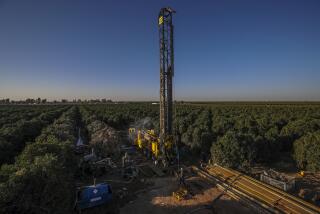California’s water house of cards
Gov. Jerry Brown’s Office of Planning and Research convened a meeting this month of groundwater experts from the University of California to determine what is currently known about the state’s underground water reserves and how they may be changing in the future. This and other recent overtures from the office are strong indications of the governor’s growing interest in the state’s complete water picture.
That picture is increasingly threatened, in particular where groundwater is concerned. California uses more of it than any other state: Nearly 20% of all groundwater withdrawals in the United States occur in California. The importance of this underground water source to the socioeconomic and environmental health of our state cannot be overemphasized.
We rely on groundwater to provide a third or more of our statewide water supply, and even more in drought years. Most of the water pumped is used for irrigation, although an increasingly large amount is being used to support energy production. Unfortunately, the vast reserve that underlies our state is being depleted at a rapid pace.
Our research, using information from NASA satellites, shows that since 2002, the Central Valley has been using groundwater at a rate of 800 billion gallons a year. That is roughly equivalent to one full Lake Mead every 12 years. Our findings are consistent with those of the U.S. Geological Survey, which paint a longer-term picture of California’s disappearing groundwater.
In the Central Valley, falling well levels and subsiding land are curtailing food production, damaging ecosystems and threatening the livelihoods of the thousands of area residents employed by the water-dependent agricultural sector. A recent report on the Coachella Valley documented decades of groundwater depletion there as well, despite local and regional efforts at managed recharge and water banking.
Clearly, food and energy production are essential, but those water needs must be balanced against domestic requirements, the needs of the environment and ecosystems, long-term preservation of groundwater supplies for future generations and the economic future of our state and nation.
The challenge of optimally allocating groundwater among its competing uses is exacerbated by California’s steadily growing population and the impacts of climate change. Warmer temperatures are already decreasing the amount of water stored as snow in the Sierra each winter. Ultimately this translates into lower river flows and less replenishment of underground aquifers.
One important outcome of the Office of Planning and Research meeting was unanimous agreement that the state’s top groundwater priority should be to implement a monitoring and management program that includes strong regional and local components. Although many in the state’s agricultural community will express discomfort over such proposals, there is little doubt that the absence of such a management framework has transformed California’s groundwater infrastructure into an unsustainable house of cards.
Imagine having a checking account, never keeping track of withdrawals and not worrying about the declining balance. As irresponsible as this may sound, it is precisely how we deal with most groundwater, not only in California but in much of the United States and around the world. Groundwater withdrawals must be monitored, levels continuously measured, and statewide and regional targets set and met.
Equally important are education and public communication. Both are essential for public engagement and support. This requires raising awareness of the state’s critical water issues to the level of everyday understanding, a burden that falls largely to those of us who research them.
The state must invest heavily in helping translate and communicate key issues to farmers and farm bureaus, to the energy sector, to the general public, to state and regional water managers, and to elected officials at all levels. We all place demands on groundwater, either directly or indirectly, and must contribute to mitigating its decline. Once people truly understand that our groundwater is disappearing and not coming back, acceptance of the need for careful monitoring is far more likely.
Finally, sound management decisions cannot be made without a sound scientific basis. Unfortunately, key decisions are often made based on politics. California’s issues are so complex that it would be inexcusable to proceed without taking advantage of some of the best available science — the vast expertise in water research from our state’s universities and national laboratories.
Without active management of California groundwater, our state’s and our nation’s food and economic, energy and water security will be increasingly at risk. The era of relative abundance is over. California needs a clear road map toward a sustainable groundwater future — and it needs one today.
Jay Famiglietti is the director of the UC Center for Hydrologic Modeling at UC Irvine. Sasha Richey is a senior doctoral candidate in the Department of Civil and Environmental Engineering at UC Irvine.
More to Read
A cure for the common opinion
Get thought-provoking perspectives with our weekly newsletter.
You may occasionally receive promotional content from the Los Angeles Times.






